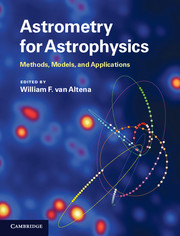Book contents
- Frontmatter
- Contents
- List of contributors
- List of acronyms
- Preface
- Part I Astrometry in the twenty-first century
- Part II Foundations of astrometry and celestial mechanics
- Part III Observing through the atmosphere
- Part IV From detected photons to the celestial sphere
- Part V Applications of astrometry to topics in astrophysics
- 22 Galactic structure astrometry
- 23 Binary and multiple stars
- 24 Binaries: HST, Hipparcos, and Gaia
- 25 Star clusters
- 26 Solar System astrometry
- 27 Extrasolar planets
- 28 Astrometricmeasurement and cosmology
- Index
- References
28 - Astrometricmeasurement and cosmology
from Part V - Applications of astrometry to topics in astrophysics
Published online by Cambridge University Press: 05 December 2012
- Frontmatter
- Contents
- List of contributors
- List of acronyms
- Preface
- Part I Astrometry in the twenty-first century
- Part II Foundations of astrometry and celestial mechanics
- Part III Observing through the atmosphere
- Part IV From detected photons to the celestial sphere
- Part V Applications of astrometry to topics in astrophysics
- 22 Galactic structure astrometry
- 23 Binary and multiple stars
- 24 Binaries: HST, Hipparcos, and Gaia
- 25 Star clusters
- 26 Solar System astrometry
- 27 Extrasolar planets
- 28 Astrometricmeasurement and cosmology
- Index
- References
Summary
Introduction
Thanks to rapid progress in observational techniques and detectors, great progress has been made in understanding the large-scale properties of the Universe. Traditionally, parameters that describe the global properties of the Universe – its density, the relative fractions of its different constituents, and its expansion rate – were derived from sequences of largely independent observations. In the case of the Hubble constant, H0, the struggle to develop the “distance ladder” is one of the great stories of twentieth-century astronomy. This effort is exemplified by the Hubble Space Telescope Key Project (Freedman et al. 2001), which returned the “headline number” H0 = 72 ± 8 km/s/Mpc. In the late 1990s, a different approach to cosmological-parameter estimation emerged: concordance cosmology. This is based on a model which describes the overall composition and evolution of the Universe -the simplest and best-known example being ACDM, or a universe dominated by cold dark matter and a “conventional” cosmological constant. These models contain a small number of free parameters, which are estimated simultaneously, usually via Monte Carlo Markov Chain (MCMC) techniques.
These approaches represent opposite but complementary pathways to determining the overall properties of our Universe. The distance ladder makes few physical assumptions but relies on a carefully concatenated series of observations, from stellar distances to extragalactic astronomy. Conversely, the concordance model encodes explicit assumptions regarding the physical mechanisms governing the overall evolution of the Universe, but may be usefully constrained by a single high-quality cosmic microwave background (CMB) data set, or a combination of a small number of data sets (e.g. CMB, with large-scale structure and supernovae).
- Type
- Chapter
- Information
- Astrometry for AstrophysicsMethods, Models, and Applications, pp. 395 - 400Publisher: Cambridge University PressPrint publication year: 2012



